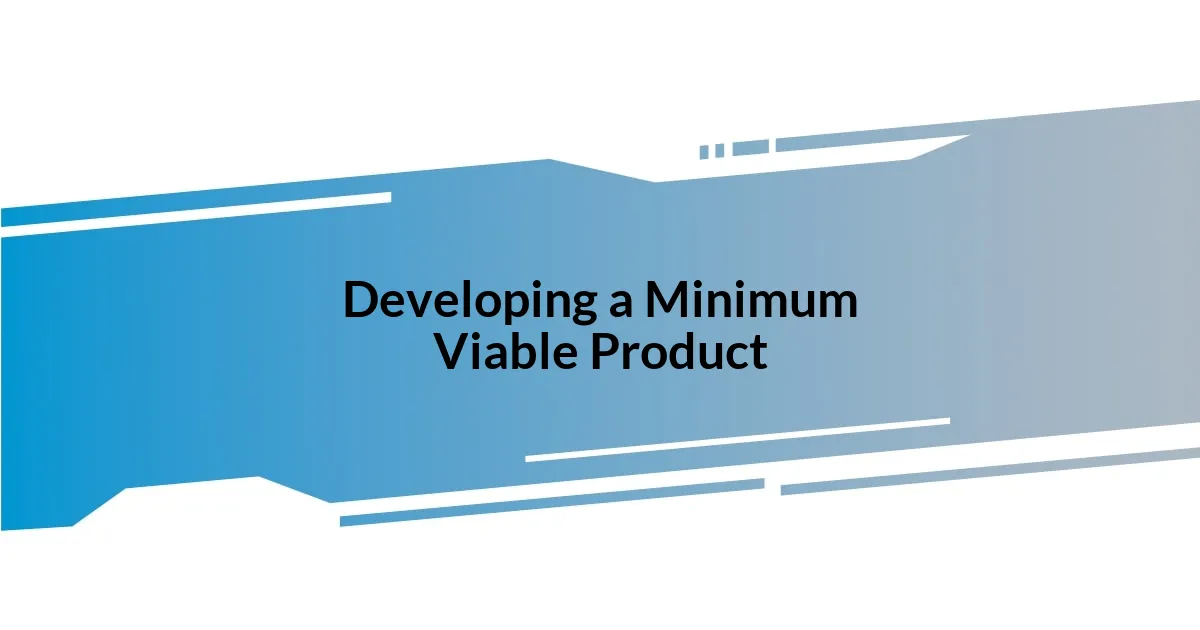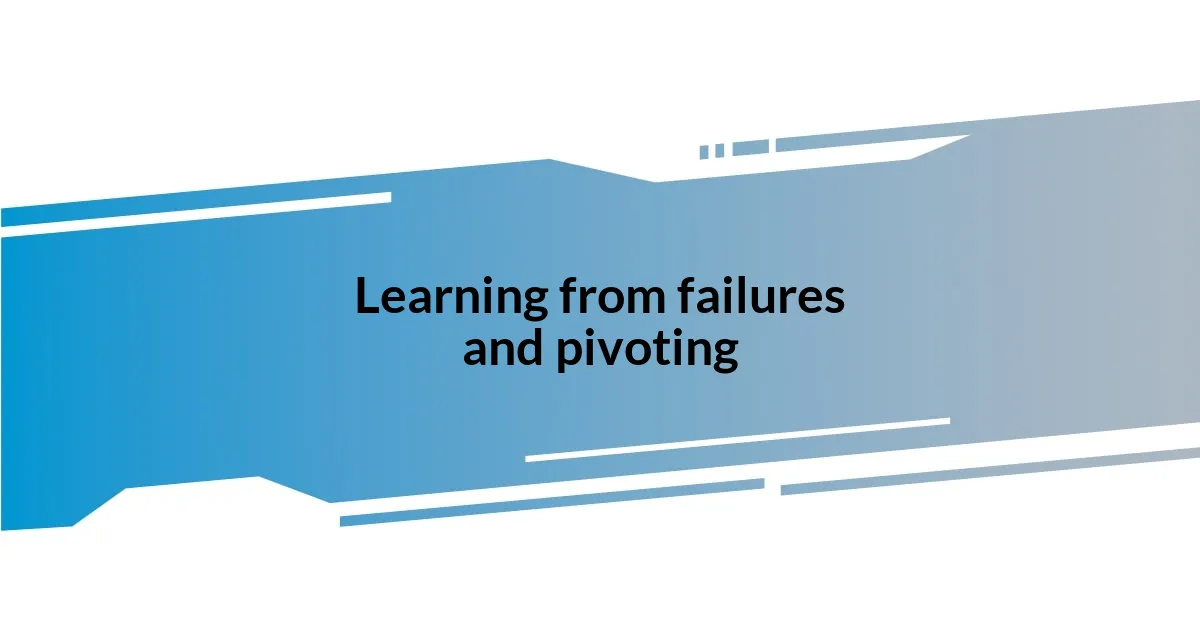Key takeaways:
- Embrace the fluidity and rapid change of the startup environment to harness innovation and creativity.
- Engage directly with customers to identify market opportunities, ensuring insights drive product development.
- Assemble a diverse team that shares a vision and encourages open communication for optimal collaboration.
- Learn from failures by staying flexible and responsive to user feedback, turning setbacks into opportunities for growth.

Understanding the startup environment
When I first stepped into the startup world, I felt an electric buzz in the air—something you just don’t find in larger companies. There’s a sense of urgency, a pulse that keeps everyone on their toes. This environment thrives on innovation and agility, which can be thrilling, but it’s also a pressure cooker. How does one navigate this chaos without feeling overwhelmed?
One of the most eye-opening experiences for me was witnessing how quickly priorities shift. In early-stage startups, I’ve seen teams pivot strategies overnight in response to market feedback or competition. This constant change can be disorienting, yet it’s also exhilarating. Have you ever had to adapt so fast that it took your breath away? Embracing this fluidity is key to surviving and thriving in such a setting.
I learned that a startup isn’t just a place for new ideas; it’s an ecosystem of resilience and creativity. The emotional highs and lows can be intense—you celebrate small victories like they’re monumental achievements, and yet setbacks feel like personal failures. This environment taught me the importance of a supportive team and constructive feedback. After all, isn’t it the collaborative spirit that fuels innovation in tech startups?

Identifying market opportunities
Identifying market opportunities starts with being attuned to the pulse of your industry. I remember a time when I was as much a spectator as a participant. Observing the changing preferences of consumers taught me that market trends don’t always announce themselves; sometimes, they whisper. A key tactic I found effective was regularly engaging with potential customers—whether through casual conversations or more formal surveys. This direct feedback often revealed needs that weren’t immediately obvious and highlighted gaps where solutions could thrive.
One enlightening experience involved noticing an emerging interest in sustainability among consumers. While initially dismissed by some, I took it seriously. I dove deep into research, attended niche events, and engaged on forums—discovering not just a trend but a genuine shift in values. These insights led my team to develop a product line centered around eco-friendliness. That venture felt incredibly rewarding, especially when I saw the enthusiasm from users whose needs we were now meeting. It was like discovering a secret door to a whole new market landscape.
To be successful, I believe in the importance of not just observing but also acting—being willing to take calculated risks. You could have all the data in the world, yet if you’re not ready to test and iterate, those insights may never transform into real opportunities. It’s this delicate balance of analysis and action that has defined my experience in tech startups.
| Method | Insights |
|---|---|
| Customer Engagement | Leads to immediate feedback on needs and potential gaps. |
| Market Research | Uncovers trends that can signify larger shifts in consumer behavior. |
| Networking Events | Offers insights and opportunities that you might miss in isolation. |

Assembling the right team
As I navigated the tumultuous waters of tech startups, I quickly learned that assembling the right team is paramount to success. I remember my first co-founder meeting—there was an instant connection that sparked creativity. It wasn’t just about skill sets; it was about shared vision and complementary personalities. Having a diverse team with varied perspectives fosters innovation, and I’ve seen firsthand how those differences can spark magical ideas that no one could have conceived in isolation.
Creating this synergy involves understanding each member’s strengths and weaknesses. I firmly believe a mix of complementary skills elevates everyone, leading to collective growth. Here’s what I’ve found helpful during my journey:
- Align Vision and Values: Ensure that all team members share the same long-term goals.
- Diversity is Key: Bring together individuals from different backgrounds for a richer blend of ideas.
- Encourage Open Communication: Promote a culture where feedback flows freely; it’s essential for growth.
- Be Adaptable: Team dynamics can shift; be ready to adapt roles as your startup evolves.
- Foster Trust: Build a foundation of trust—it’s vital for collaboration and problem-solving.
I’ve experienced how a unified team can transform obstacles into opportunities. Remembering the late nights of brainstorming sessions, fueled by passion and takeout, really highlights how chemistry can ignite productivity. It’s those moments that reassure me we have the right people, propelling us forward in this fast-paced landscape.

Developing a Minimum Viable Product
Developing a Minimum Viable Product (MVP) has been a game-changer in my journey through tech startups. When I first approached the concept, I was overwhelmed by the pressure to create a ‘perfect’ product. However, I learned that the MVP is all about speed and function—a basic version of your idea that validates your concept without the bells and whistles. I remember launching my first MVP with only core features, and the feedback was invaluable. It helped me refine my approach and focus on what really mattered to my users.
One of my most memorable experiences was when a key customer pointed out a feature I thought was unnecessary. Initially, I brushed it off, thinking I knew better. But after a few iterations based on that feedback, that same feature became one of the most popular aspects of the product. It taught me a crucial lesson: your assumptions can blind you to what users truly want. Have you ever thought you understood your audience, only to find out you had completely missed the mark? It’s a humbling realization and one that underlines the importance of continuous learning through the MVP process.
I’ve also found that timing is everything. During the development of one of my products, we were racing against a market shift. Developing an MVP allowed us to enter the market quickly, and that gave us a first-mover advantage. I was reminded of the adrenaline rush of those early days; every bit of feedback felt like a win. It reinforced my belief in the philosophy of iteration—get it out there, learn from your users, and improve over time. The MVP journey isn’t just about launching a product; it’s about building a relationship with your audience and transforming their insights into development fuel.

Gaining initial traction and feedback
Gaining initial traction and feedback can feel like a daunting task, but I’ve discovered it’s all about engaging your audience early on. In my experience, hosting beta testing sessions with a select group of users was eye-opening. I remember sitting in a dimly lit room, watching as they interacted with the product for the first time; their reactions were pure gold. Did they connect with the interface? Did they find value in the features? It’s fascinating how honest feedback can reshape your original vision.
I also leveraged social media to gather insights. Creating a buzz on platforms like Twitter and LinkedIn helped me reach a wider audience before the official launch. One day, as I monitored the comments and questions flooding in, I felt a wave of excitement—it was like having a pulse on the market! I often found myself asking: What do my potential users really care about? Each response guided my next steps. It wasn’t just about promoting the product; it was about starting a conversation that informed our development.
Ultimately, every bit of feedback, whether positive or critical, can steer your startup’s direction. I fondly recall a late-night brainstorming session where we brainstormed on how to address user concerns. It transformed our approach and gave me renewed focus. Wouldn’t it be incredible to build something shaped by the very people you’re trying to serve? That sense of co-creation not only builds loyalty but fosters innovation in ways you could never have anticipated before diving into the feedback loop.

Scaling the startup effectively
Scaling a startup effectively is all about finding the right balance between growth and sustenance. I vividly recall the transition period when one of my startups began gaining traction. It felt exhilarating, but also overwhelming; the demand surged overnight. I learned quickly that you can’t simply throw more resources at the problem. Instead, we focused on refining our operational processes, ensuring we could maintain quality while expanding. Have you ever felt like the momentum just might sweep you off your feet? It’s crucial to harness that wave without losing sight of the core values that got you there in the first place.
One essential lesson I learned during this phase was the significance of building a scalable team. Initially, I hesitated to delegate responsibilities, fearing that my vision would dilute. But once I started trusting my team and empowering them to take ownership, everything shifted. I could hear the fresh ideas bubbling up from all corners, leading to innovations I hadn’t even considered. It’s almost magical how collaboration can elevate your startup. Have you ever experienced that moment when a collective effort becomes greater than the sum of its parts? I found that bringing in diverse skill sets not only lightened my load but also injected new energy into our growth strategy.
Additionally, understanding and leveraging key performance indicators (KPIs) transformed how we approached scaling. I remember a specific moment when we analyzed our user retention metrics and realized how integral this insight was to our growth. Rather than getting carried away by user acquisition numbers alone, we shifted focus towards creating a loyal user base. The process felt like peeling back the layers of an onion, each insight bringing us closer to our core purpose. Have you ever taken a step back and asked yourself what truly matters for your startup’s success? It’s in those reflective moments that you can realign your efforts towards sustainable scaling, ensuring your startup grows without losing its essence.

Learning from failures and pivoting
Failure in a tech startup can often feel like a heavy blow. I’ve faced my share of setbacks, and at one point, I found myself staring at a product that just wasn’t resonating with users. It was a sobering moment—like a hard slap of reality. But in that quiet, reflective space, I learned that failure isn’t the end; it’s a powerful teacher. Have you ever found yourself grappling with a situation that didn’t turn out as planned? I certainly have, and those experiences taught me to analyze what went wrong and pivot quickly. Each stumble became a stepping stone, guiding my next moves.
During one particularly challenging project, our team launched a feature meant to spark excitement, yet user engagement plummeted instead. It was tempting to dig in my heels and push for a change, but instead, we gathered around the whiteboard with a fresh perspective. I distinctly remember how energized the team felt as we dissected feedback and charted a new course. Emerging from that brainstorming session felt invigorating; we realized that sometimes, stepping back is the best way to leap forward. What did we learn? Flexibility is crucial, and a willingness to let go of past decisions can lead to unexpected breakthroughs.
Ultimately, it’s about staying attuned to the market and your users. After a setback, I took it upon myself to connect with users directly. I hosted informal coffee chats and listened intently to their stories. One gentleman shared his frustrations candidly, and it struck a chord with me. That experience reminded me that a pivot isn’t merely a strategy; it’s a heart-driven response to the needs of real people. How often do we really ask ourselves what our customers are telling us? Engaging on such a human level not only informed our direction but reignited my passion for the project. In the end, it’s those connections that turn obstacles into opportunities for growth.